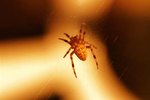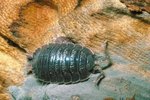
Mealworms are not truly a worm but rather the larval form of darkling beetles. At this stage, the mealworm’s primary goals are to eat and grow. After 3 to 5 months, they will metamorphose into a pupa, which will in turn metamorphose into a darkling beetle. Mealworms have several interesting adaptations that allow them to eat and defend themselves against predators so that they can survive into adulthood.
Mealworm Eating Adaptations
Mealworms have a small mouth and labrum, a lip-like component that helps them ingest food. They can only fit small amounts of food into their mouth, but they are good at absorbing moisture from this food. Their diet consists largely of debris like decaying leaves, grasses and sticks, although they will also eat new plant growth. Their abdomen stores a lot of the fat from all the food they consume, allowing them to grow and progress to the next life cycle.
Mealworm Defense
The mealworm has many natural predators, including lizards, rodents, spiders, birds and predatory beetles. To protect themselves, they have adapted to be very good at burrowing into the ground. Their six short legs near the front of their body do not allow them to move quickly on top of the ground, but their legs and claws are well-suited to burrowing. They have poorly developed eyes since they prefer to spend most of their time underground and instead rely on their antennae to act as feelers and help them navigate.
Mealworm Growth
During its 3 to 5 month life cycle, a mealworm may molt between 9 and 20 times, allowing it to continue growing larger without being restricted by its hard exoskeleton. After each molt, the larva expands before its new protective exoskeleton forms. Mealworms progress through their life cycle most quickly when they are in a dry, dark, and warm environment. They will barely grow at all if the temperature is too cold.
The Next Life Cycle
Once it has finished growing, the mealworm becomes a pupa. This is similar to a caterpillar forming a chrysalis to become a butterfly. The pupa stage lasts around 2 or 3 weeks, at which point the pupa will split open to reveal the adult darkling beetle that has grown inside. Over the first few days of this stage, the beetle turns from white to brown to its familiar black color. Like the mealworm, it has a hardened exoskeleton to protect itself.
References
Photo Credits
-
Thomas Northcut/Photodisc/Getty Images
Writer Bio
Juliana Weiss-Roessler has been writing since 2000. She worked as the head of the Web content department for the star of an Emmy-nominated reality series. Her ghostwriting has appeared in "PARADE" and "People." Weiss-Roessler is a blogger for Resumark and an editor for Pink Raygun. She has a Bachelor of Arts in English from the University of Florida.



